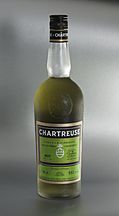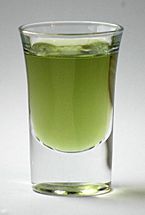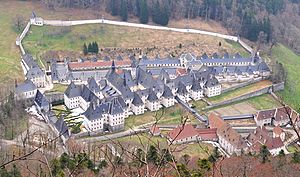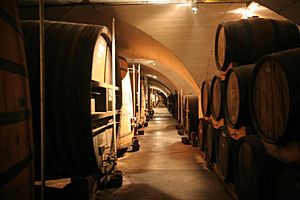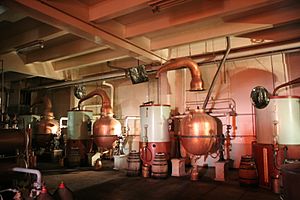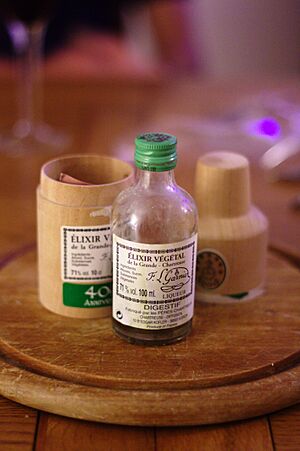Chartreuse (liqueur) facts for kids
|
A bottle of Green Chartreuse
A shot of Green Chartreuse
|
|
| Type | Liqueur |
|---|---|
| Manufacturer | Carthusian monks |
| Country of origin | France |
| Introduced | 1764 |
| Alcohol by volume | 40–69 |
| Proof (US) | 80–138 |
| Color | Chartreuse |
| Flavor | Herbal |
Chartreuse is a special French herbal drink. It comes in two main colors: green and yellow. These two types taste different and have different amounts of alcohol.
Carthusian monks have been making this drink since 1737. They follow a very old secret recipe. This recipe was given to them in 1605. The drink gets its name from the Grande Chartreuse monastery. This monastery is in the Chartreuse Mountains in France. The monks make Chartreuse in their distillery in Aiguenoire. It is made from distilled alcohol mixed with 130 different herbs, plants, and flowers.
Contents
History of Chartreuse
How the Secret Recipe Began
The story says that a French military leader, François Hannibal d'Estrées, gave the Carthusian monks a special old book in 1605. This book contained a recipe for an "elixir of long life." An elixir is like a magical potion.
This recipe eventually reached the monks' main monastery. The recipe is said to use 130 herbs, plants, and flowers. It also has secret ingredients. In 1737, a monk named Brother Gérome Maubec improved the recipe.
Becoming a Popular Drink
The drink quickly became popular. In 1764, the monks changed the elixir recipe. They made what is now known as the "Elixir Végétal de la Grande Chartreuse."
Times of Trouble and Return
In 1793, the monks were forced to leave France. This meant they stopped making the drink. A copy of the recipe was kept at the monastery. The original recipe left with the monks. A monk was arrested, but he secretly passed the recipe to a friend.
This friend thought the monks would not return. He sold the recipe to a pharmacist. Later, the French leader Napoleon asked for all secret medicine recipes. The Chartreuse recipe was sent but was returned. It was not considered a secret medicine. When the pharmacist died, his family gave the recipe back to the monks. The monks had returned to their monastery in 1816.
New Versions of Chartreuse
In 1840, the monks created two new versions. They made a milder one called Green Chartreuse. They also made a sweeter one called Yellow Chartreuse.
Leaving and Coming Back Again
The monks were forced to leave their monastery again in 1903. The government took their property. The monks took their secret recipe to Spain. They started making their drinks there. They used the same label but added a note saying it was made in Spain.
At the same time, a company in France tried to make Chartreuse. They did not have the monks' secret recipe. The monks stopped this company from selling their drink in many countries. This was because the monks owned the trademark for Chartreuse.
The French company did not sell much. By 1929, it was almost out of business. Some local business people bought the company's shares. They gave them as a gift to the monks in Spain.
The Carthusian monks got their distillery back. They returned to France and started making Chartreuse again. In 1935, a mudslide destroyed the distillery. The French government helped the monks rebuild it. After World War II, the monks were allowed to live in France legally again.
Where Chartreuse is Made Today
Today, only two monks at Grande Chartreuse know the secret recipe. They prepare the special herbal mixture. A company called Chartreuse Diffusion handles the bottling, packaging, and tours. In 2017, the distillery moved to Aiguenoire for safety reasons.
What is in Chartreuse?
Chartreuse is made from 130 different plants, herbs, and flowers. The exact recipe is a secret. Only a few monks know it at any time. The monks originally made this drink to be used as a medicine.
Chartreuse is also used in some mixed drinks. These are called cocktails. Examples include the Cloister and Last Word.
Types of Chartreuse
Green Chartreuse
Green Chartreuse is a naturally green drink. It has 55% alcohol. It is made by soaking 130 herbs and plants in alcohol. This process takes about eight hours. The plants give the drink its green color. The modern version of Green Chartreuse came out in 1840.
Yellow Chartreuse
Yellow Chartreuse has a milder and sweeter taste. It has 40% alcohol. It is less strong than Green Chartreuse.
Chartreuse VEP
VEP stands for "Vieillissement Exceptionnellement Prolongé." This means "exceptionally prolonged aging." This type is made using the same secret recipe. It is aged for a very long time in oak barrels. This extra aging makes it very high quality. Chartreuse VEP comes in both yellow and green.
Élixir Végétal de la Grande-Chartreuse
This version is very strong, with 69% alcohol. It uses the same 130 plants and flowers. It is sometimes called a tonic. It is sold in small bottles covered in wood.
What Does Chartreuse Taste Like?
Chartreuse has a very strong and unique taste. It is sweet but also spicy and herbal. It tastes like many different plants. You can drink it very cold or at room temperature.
Because its flavor is so strong, some mixed drink recipes use only a few drops. In French ski resorts, people sometimes mix it with hot chocolate. This drink is called Green Chaud.
Chartreuse is one of the few drinks that get better with age. It continues to improve even after it is bottled.
Awards and Recognition
Chartreuse drinks have won many awards. Green Chartreuse has won silver and double gold medals in competitions. It has also received high scores from experts. The VEP Green and VEP Yellow versions have also earned impressive scores.
How Chartreuse Influenced Colors
The color "chartreuse green" is named after Green Chartreuse. This color name was first used in 1884. There is also a color called "chartreuse yellow." This color was named after Yellow Chartreuse in 1892. It is now called "chartreuse yellow" to avoid confusion with the green color.
See also
 In Spanish: Chartreuse (licor) para niños
In Spanish: Chartreuse (licor) para niños


